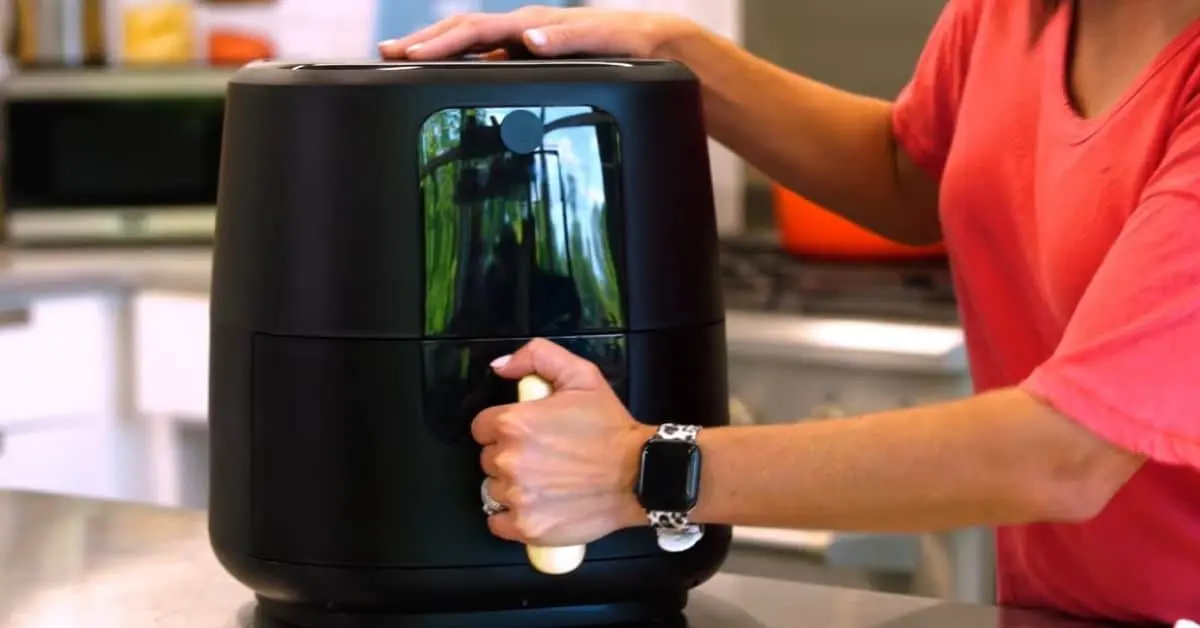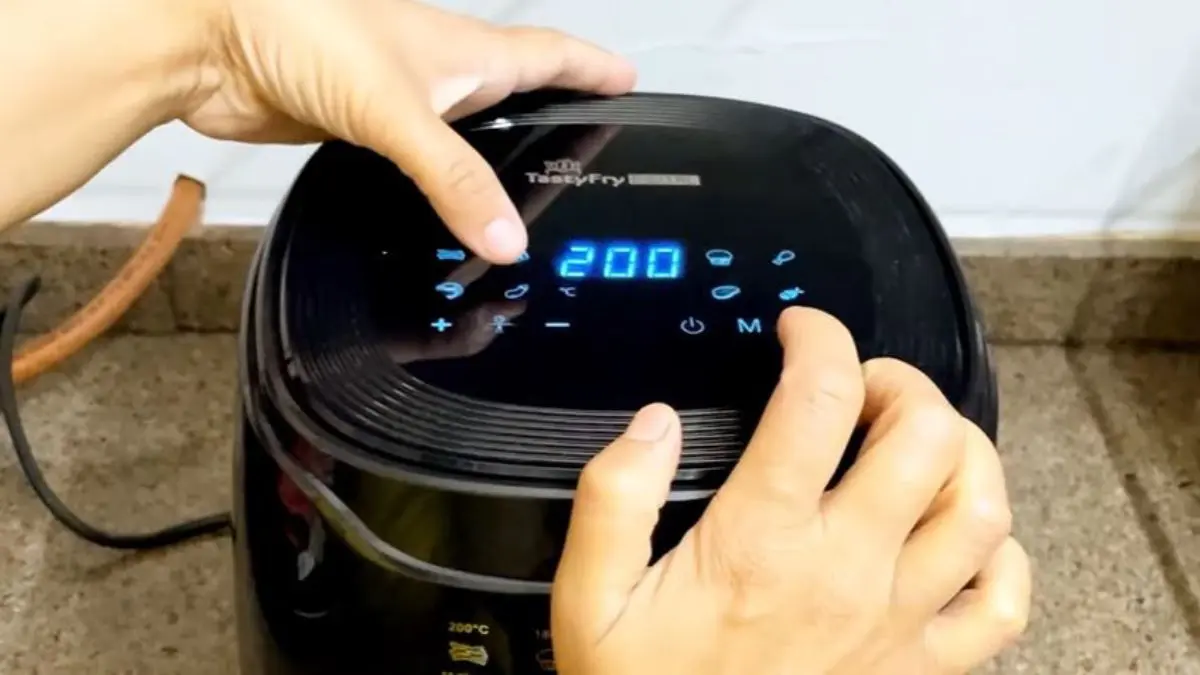If you’re in the market for a powerful air fryer oven, you’ve probably come across the Ninja SP301 and Ninja SP351. Both models come from Ninja’s high-performance lineup, promising multi-functionality, rapid cooking times, and crispy, golden-brown results without excessive oil. But with such similar names and features, choosing between them can feel like a guessing game.
I’ve spent time researching both models to see what sets them apart—and let me tell you, while they share a lot of similarities, some key differences could make one the better choice for your kitchen. Whether you’re after advanced cooking technology, a wider temperature range, or simply the best value for your money, I’ll break it all down for you.
In this comparison, we’ll go over design, cooking performance, features, and overall value to help you decide which one deserves a spot on your countertop. Let’s get into it!
Quick Comparison Table
Here’s a side-by-side look at the Ninja SP301 and Ninja SP351 to help you quickly spot the differences:
| Feature | Ninja SP301 | Ninja SP351 |
| Dimensions | 20.21″ x 15.33″ x 8.15″ | 20.21″ x 15.33″ x 8.15″ |
| Weight | 21.1 lbs | 21.1 lbs |
| Cooking Functions | 13 (Air Fry, Bake, Broil, Toast, etc.) | 13 (Same as SP301) |
| Smart Thermometer | No | Yes |
| Max Temperature | 450°F | 500°F |
| Cyclonic Air Technology | No | Yes |
| Preheat Time | 60 seconds | 60 seconds |
| Capacity | Fits a 13-inch pizza or 6 chicken breasts | Fits a 13-inch pizza or 6 chicken breasts |
| Material | Stainless Steel | Stainless Steel |
| Control Panel | Digital with knobs | Digital with knobs |
| Price Range | Lower | Slightly Higher |
At first glance, both air fryer ovens look nearly identical in size, design, and cooking functions. However, the Ninja SP351 stands out with a smart thermometer, a higher max temperature (500°F vs. 450°F), and Cyclonic Air Technology, which helps with even crisping and browning. If those features matter to you, the SP351 might be worth the extra cost.
Ninja SP301 Review – My Hands-On Experience
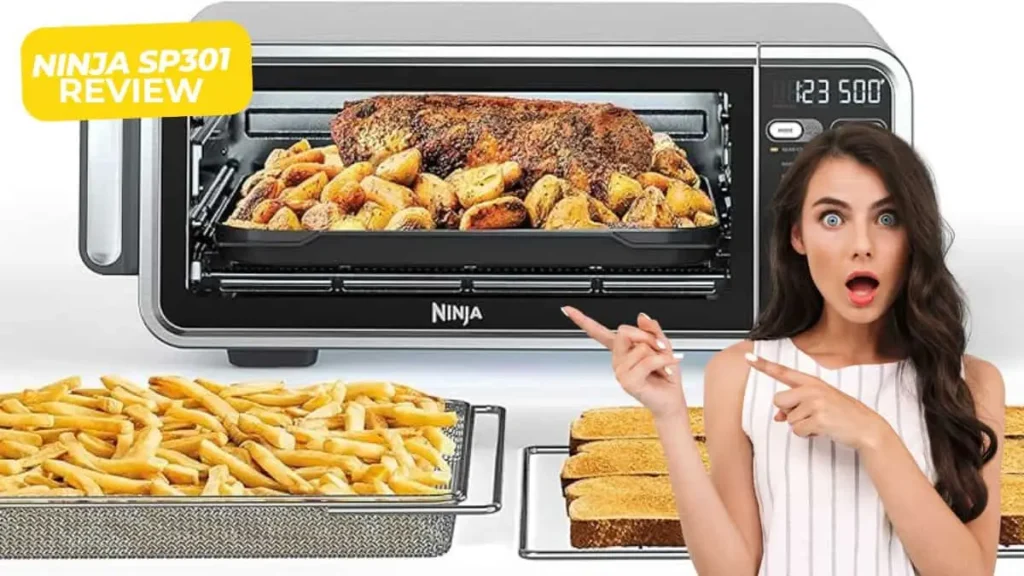
The Ninja SP301 Dual Heat Air Fry Oven promises restaurant-quality crisping, baking, and air frying in a compact countertop design. I spent weeks putting it to the test—making everything from crispy chicken wings to perfectly toasted sandwiches. Here’s my honest take on how it performs in a real kitchen.
Product Overview
At first glance, the Ninja SP301 looks like a standard air fryer oven, but it packs 13 different cooking functions, including Air Fry, Bake, Broil, Toast, and Rapid Bake. Its Dual Heat Technology combines a direct sear plate with powerful convection heating, making it more versatile than a traditional air fryer.
The compact, flip-up design is great for saving counter space. After cooking, it can be stored vertically against the backsplash, which is a huge plus for small kitchens. The digital control panel is simple to use, with knobs for selecting temperature and time, plus dedicated buttons for each cooking function.
From a size perspective, it fits a 13-inch pizza, 6 chicken breasts, or a small batch of cookies—enough for a family but not oversized. Preheating takes just 60 seconds, making it faster than a conventional oven.
What I Like About the Ninja SP301
1. Dual Heat Technology Makes a Difference
One of the biggest advantages is Dual Heat Technology, which combines convection heat with a direct heated sear plate. This means steaks, burgers, and paninis come out with crisper exteriors and juicy interiors—something most air fryers struggle with.
2. Super Fast Preheat and Cooking Times
Unlike a traditional oven that can take 10–15 minutes to preheat, the Ninja SP301 is ready in 60 seconds. It also cooks food faster—French fries took about 15 minutes, while chicken breasts were perfectly cooked in 20 minutes.
3. Space-Saving Flip-Up Design
This feature is a game-changer if you’re short on counter space. The unit can be flipped up and stored vertically, reducing its footprint by about 50%.
4. Even Cooking Results
Whether air frying, baking, or toasting, the results were evenly cooked with no cold spots. The powerful fan ensures food gets crispy all around without needing to be rotated constantly.
5. User-Friendly Controls
The digital panel is intuitive, with simple knobs for adjusting temperature and time. There are no confusing presets—just straightforward, manual control over every function.
What Could Be Better?
1. No Smart Thermometer
Unlike the Ninja SP351, this model doesn’t include a smart thermometer. If you like to cook meat to precise doneness, you’ll have to rely on a separate meat thermometer.
2. Max Temperature is Lower Than the SP351
The 450°F max temperature is great for most cooking tasks but falls short compared to the 500°F of the SP351. If you want extra browning and searing power, the upgraded model might be a better fit.
3. Requires Frequent Cleaning
The interior and the sear plate collect grease and crumbs quickly, so cleaning is needed after almost every use. While the parts are nonstick, it still requires regular wiping and occasional deep cleaning.
My Cooking Experience with the Ninja SP301
Air Frying Performance
I started with the classic test—French fries. Using frozen fries, I set the unit to Air Fry mode at 400°F for 15 minutes. The result? Crispy, golden fries with a soft interior—far superior to what a traditional oven would produce. Next, I tried breaded chicken tenders, which came out perfectly crispy on the outside and juicy inside.
Baking and Roasting
To test its baking function, I made a batch of chocolate chip cookies. I used the Bake function at 350°F for 12 minutes, and the cookies came out evenly cooked with a golden-brown edge. For roasting, I cooked chicken thighs with seasoning—they were done in about 25 minutes, with crispy skin and juicy meat.
Searing with the Sear Plate
One of the most impressive features was the sear plate, which worked amazingly well for steaks. I tested a 1-inch thick ribeye, preheated the sear plate for 5 minutes, and cooked each side for 3 minutes at 450°F. The result was a nice crust with a tender, medium-rare center—something I wouldn’t expect from an air fryer.
Toasting and Reheating
For breakfast, I used the Toast function to make bagels and English muffins. They toasted evenly and had a good crunch. Reheating pizza was another win—using Air Roast at 375°F for 5 minutes, the crust stayed crisp while the cheese melted perfectly.
Ninja SP351 Review – My Hands-On Experience
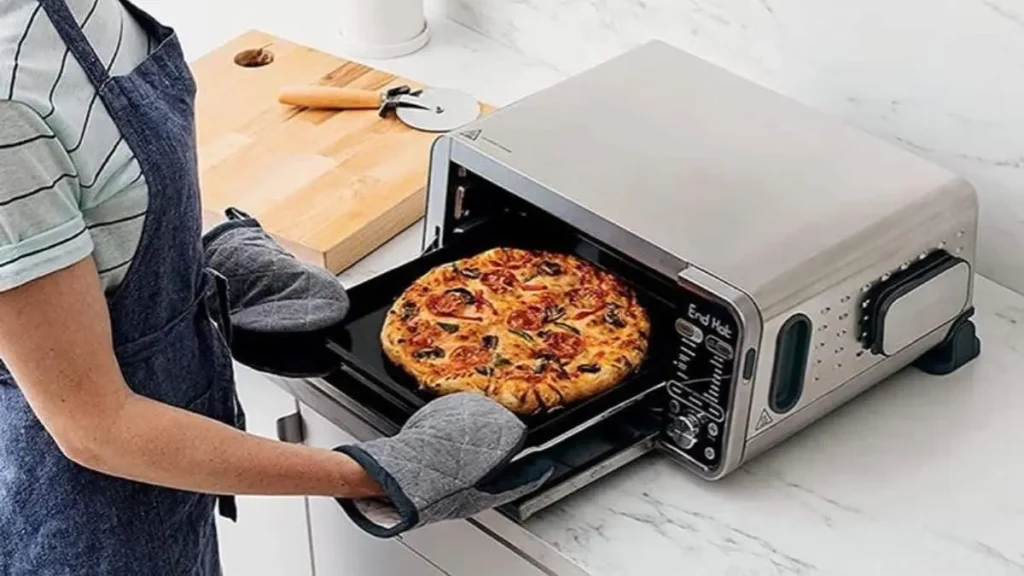
The Ninja SP351 Foodi Smart Dual Heat Air Fry Oven is an upgraded version of the SP301, boasting a higher max temperature (500°F) and an integrated smart thermometer for precision cooking. After testing it extensively, I found that while it shares many similarities with the SP301, it brings some notable improvements. Here’s my hands-on review, covering everything from build quality to real-world cooking results.
Product Overview
At first glance, the Ninja SP351 looks identical to the SP301, featuring the same sleek stainless steel design with a flip-up storage option to save counter space. However, the real difference lies in its upgraded Smart Cook System and higher temperature capability, which allows for better searing, crisping, and more precise cooking results.
It includes 13 cooking functions, ranging from Air Fry, Bake, and Toast to Broil, Sear Crisp, and Smart Cook. The built-in smart thermometer sets it apart, allowing you to cook meats to an exact doneness level—no more guesswork when making steak, chicken, or fish.
The capacity remains the same as the SP301, comfortably fitting a 13-inch pizza, six chicken breasts, or a 4-lb roast. The 60-second preheat time makes it just as fast, and the digital controls are straightforward, with an intuitive interface for adjusting time, temperature, and cooking functions.
What I Like About the Ninja SP351
1. Higher Max Temperature for Better Searing
Unlike the 450°F limit on the SP301, the SP351 reaches 500°F, making a noticeable difference when searing meats or browning casseroles. The added heat creates a crispier crust on steaks and helps achieve better caramelization when roasting vegetables.
2. Smart Thermometer for Precision Cooking
This is a standout feature. The built-in smart thermometer allows you to set and forget meat while it cooks. I tested it with chicken breasts, selecting a 165°F internal temperature, and the Ninja shut off automatically when the meat was perfectly cooked. No overcooking, no guesswork.
3. Dual Heat Technology with Sear Plate Works Wonderfully
Like the SP301, this model features Dual Heat Technology, but the extra heat makes the sear plate even more effective. Cooking steaks, burgers, and salmon resulted in deeply caramelized crusts while keeping the inside moist and tender.
4. Space-Saving Flip-Up Design
If you have limited kitchen space, this feature is a lifesaver. Once cooled, the unit flips up, taking up 50% less space on the counter. It’s especially useful in small apartments, RVs, or kitchens with limited storage.
5. Versatile Cooking Modes and Even Heating
The SP351 delivers consistent results across all cooking functions. I noticed no cold spots, and whether I was baking, air frying, or roasting, everything came out evenly cooked. The Rapid Bake function speeds up baking without drying out food.
What Could Be Better?
1. The Price is Higher
While the smart thermometer and higher temperature justify the price, the SP351 is more expensive than the SP301. If you don’t need precise meat doneness control, the SP301 might be a better value.
2. Can Get Hot on the Outside
During extended use, the exterior gets noticeably warm, especially near the top vent. While it’s not a dealbreaker, I had to make sure it was placed away from other appliances to prevent heat damage.
3. Slightly More Complicated Setup
Because of the smart thermometer and extra cooking modes, there’s a bit more of a learning curve compared to the SP301. It took a few tries to fully understand how to use the thermometer effectively.
My Cooking Experience with the Ninja SP351
Air Frying Performance
I tested chicken wings first, setting the Air Fry function at 400°F for 20 minutes. The wings came out crispy on the outside and juicy inside with minimal oil—better than what I typically get from a regular oven. Next, I tried mozzarella sticks, which were evenly browned with a perfect cheese pull.
Baking and Roasting
For baking, I made banana bread using the Bake function at 325°F for 45 minutes. The result was moist inside with a golden crust. I also roasted brussels sprouts at 425°F for 15 minutes, and the extra heat helped caramelize them beautifully.
Searing with the 500°F Sear Plate
The 500°F direct heat is where the SP351 shines. I cooked a 1.5-inch thick New York strip steak, preheating the sear plate for 5 minutes. After 4 minutes on each side, it had an impressive seared crust that rivaled my cast-iron skillet.
Using the Smart Thermometer for Precision Cooking
For a medium-rare steak (130°F internal temp), I used the Smart Cook System to set my preferred doneness. The thermometer tracked the temperature and shut off automatically when the steak reached 130°F—resulting in a perfectly pink center without overcooking.
Toasting and Reheating
I tested the Toast function with bagels and sourdough bread, and the SP351 toasted more evenly than my standard toaster. Reheating leftover pizza at 375°F for 6 minutes kept the crust crispy while melting the cheese perfectly.
Ninja SP301 vs SP351 – Head-to-Head Comparison
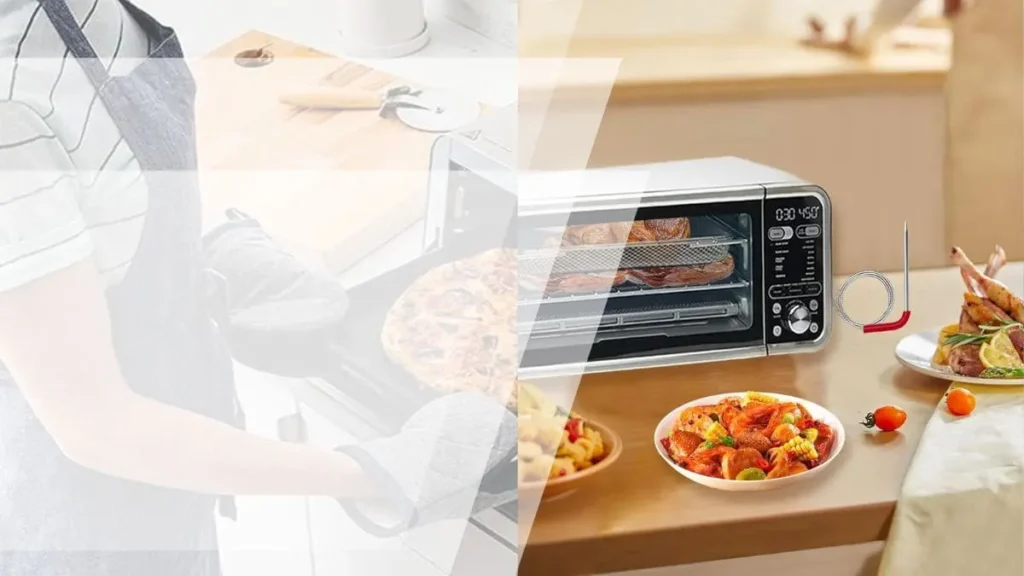
After extensively testing both the Ninja SP301 and Ninja SP351, I’ve noticed that while they share a similar design and feature set, the SP351 brings some key upgrades—particularly in temperature control and smart technology.
Design & Build Quality
At first glance, the Ninja SP301 and SP351 look almost identical. Both feature a compact stainless steel build, an innovative flip-up storage design, and a large cooking capacity that accommodates a 13-inch pizza, six chicken breasts, or a 4-lb roast. The control panel layout is the same, with an intuitive digital display and function selector dial.
However, the SP351 includes an integrated smart thermometer, which slightly alters its interface. This addition doesn’t change the size or weight significantly, but it does add a small probe storage slot on the side for convenience.
Both models feel sturdy and well-built, with solid hinges and a smooth-opening door. The stainless steel surface is easy to wipe down, but it does tend to show fingerprints—especially after handling greasy foods.
Key Differences in Design:
- The SP351 includes a built-in smart thermometer, while the SP301 does not.
- Both share a stainless steel finish, but the SP351 has an additional storage slot for the thermometer.
- Size and weight are nearly identical, making both equally space-efficient.
Performance & Cooking Versatility
Both models offer Dual Heat Technology, which combines direct heat from the sear plate with rapid air circulation for faster and crispier cooking results. However, the SP351 has a higher max temperature of 500°F, compared to the 450°F limit on the SP301.
During testing, I found that the extra 50°F makes a noticeable difference when searing steaks, broiling meats, and achieving deep caramelization on roasted vegetables. The SP301 still performs well, but if you regularly cook foods that require high heat, the SP351 provides better results.
Both models offer 13 cooking functions, including Air Fry, Bake, Toast, Broil, Sear Crisp, and Rapid Bake. I tested air frying with both, cooking chicken wings at 400°F for 20 minutes, and the results were almost identical—crispy on the outside and juicy inside.
When roasting vegetables, I noticed that brussels sprouts browned slightly better in the SP351 due to the higher heat. Baking results were consistent in both, with banana bread and cookies turning out evenly cooked without hot spots.
Key Differences in Performance:
- The SP351 reaches 500°F, while the SP301 maxes out at 450°F.
- The higher temperature on the SP351 improves searing and caramelization.
- Both models have 13 cooking functions, offering the same versatility.
Smart Features & Technology
This is where the SP351 takes a clear lead. The Smart Cook System with an integrated thermometer is the biggest difference between the two models. This feature allows the SP351 to track the internal temperature of meats in real time and automatically shut off when they reach the desired doneness.
I tested the smart thermometer with a medium-rare steak, setting it to 130°F. The SP351 cooked it perfectly pink in the center, shutting off precisely at the target temperature. In contrast, with the SP301, I had to rely on an external thermometer, which required more manual monitoring.
For those who frequently cook meats, poultry, or fish, the SP351’s Smart Cook System is a game-changer. It eliminates the guesswork, making it ideal for precise cooking.
Key Differences in Smart Features:
- The SP351 includes a built-in smart thermometer, while the SP301 does not.
- The Smart Cook System in the SP351 allows for precise meat doneness tracking.
- Both models have pre-programmed cooking functions, but the SP351’s thermometer adds extra precision for meat cooking.
Ease of Use & Cleaning
Both models are user-friendly, with an intuitive digital control panel and quick preheat times. The SP301 and SP351 heat up in just 60 seconds, making them significantly faster than a traditional oven.
Cooking functions are clearly labeled, and switching between them is seamless. However, using the smart thermometer on the SP351 requires a small learning curve—once you understand it, though, it simplifies cooking.
In terms of cleaning, both models include a removable crumb tray, nonstick sear plate, and dishwasher-safe accessories. However, the sear plate in both models requires some scrubbing after high-heat cooking. The SP351’s smart thermometer probe needs careful hand-washing to maintain accuracy.
Key Differences in Usability & Cleaning:
- The SP351’s smart thermometer adds an extra feature to learn, but it simplifies cooking once mastered.
- Both models are easy to clean, but the sear plate requires more scrubbing after high-heat cooking.
- The SP351’s smart probe needs hand washing, while the SP301 has no probe to clean.
Price & Value for Money
The SP351 is more expensive than the SP301, primarily due to the higher temperature capability and the smart thermometer. If you frequently cook meats, sear steaks, or want precision doneness control, the extra cost is justified.
However, if you don’t need the smart thermometer and don’t cook at ultra-high temperatures, the SP301 offers nearly the same performance for a lower price.
Ultimately, the choice comes down to your cooking needs. If you prioritize high-heat searing and smart cooking technology, the SP351 is worth the investment. But if you just need a solid, versatile air fryer oven with great performance, the SP301 remains an excellent choice.
Key Differences in Price & Value:
- The SP351 costs more due to its smart thermometer and higher temperature capability.
- If you don’t need precision temperature control for meats, the SP301 offers better value.
- Both models deliver excellent performance, but the SP351 caters to those who want more control over doneness levels.
You Should Also Read: Ninja SP101 vs SP201: Which Air Fry Oven Should You Buy?
FAQs – Answering Common Questions
When choosing between the Ninja SP301 and SP351, many buyers have common concerns regarding their performance, features, and usability. Here are the answers to some frequently asked questions to help you make an informed decision.
Does the Ninja SP301 or SP351 take up a lot of counter space?
Both models have a compact footprint and feature Ninja’s unique flip-up design, which allows them to be stored vertically when not in use. This makes them ideal for small kitchens or those who want to maximize counter space.
Can both models replace a traditional oven?
While neither the SP301 nor SP351 can fully replace a conventional oven for large-scale baking or roasting, they do cook much faster and can handle most everyday meals, including air frying, toasting, roasting, broiling, and baking. The SP351’s higher temperature gives it an advantage for searing meats and crisping food faster.
Is the Ninja SP351’s smart thermometer worth the extra cost?
If you frequently cook meats and want precise doneness without manually checking with an external thermometer, then yes, the smart thermometer in the SP351 is worth it. It ensures steaks, chicken, and roasts are cooked perfectly without overcooking. However, if you don’t need this feature, the SP301 offers nearly identical cooking functions at a lower price.
Do both models require preheating?
Yes, but preheating is extremely fast—both models heat up in just 60 seconds, significantly quicker than a traditional oven.
Can I bake in the Ninja SP301 and SP351?
Yes! Both models offer a Bake function, which works well for cakes, muffins, cookies, and bread. The SP351’s higher temperature allows for faster browning, but otherwise, both deliver consistent baking results.
Can I use aluminum foil or parchment paper inside these models?
Yes, but with caution. Aluminum foil can be used in the air fry basket or on the sheet pan, but it should not block airflow. Parchment paper is safe for baking and air frying, as long as it doesn’t touch the heating elements.
Final Verdict – Which One Should You Buy?
Both the Ninja SP301 and SP351 are excellent countertop ovens, offering versatility, fast cooking, and air frying capabilities. The SP301 is ideal for those who want a powerful multi-cooker at a lower price, while the SP351 is best for people who want maximum precision in meat cooking and higher temperature control.
If you cook meats often, want a built-in smart thermometer, and prefer better searing at 500°F, go for the SP351.
If you don’t need the smart thermometer and are okay with a 450°F max temperature, the SP301 offers nearly identical performance for a lower price.
Both are great investments, but the SP351’s extra features make it the better option for precision cooking enthusiasts.



